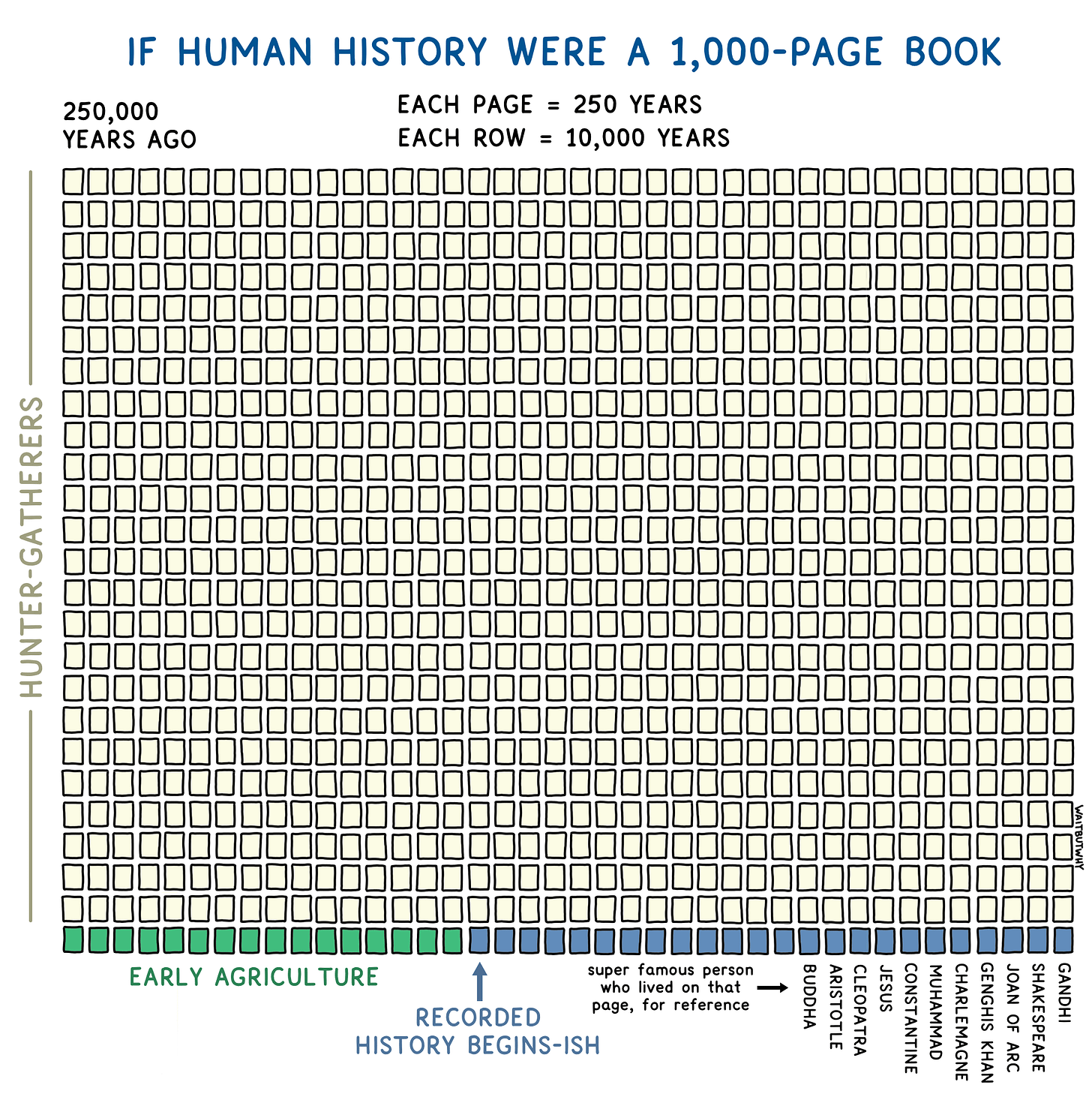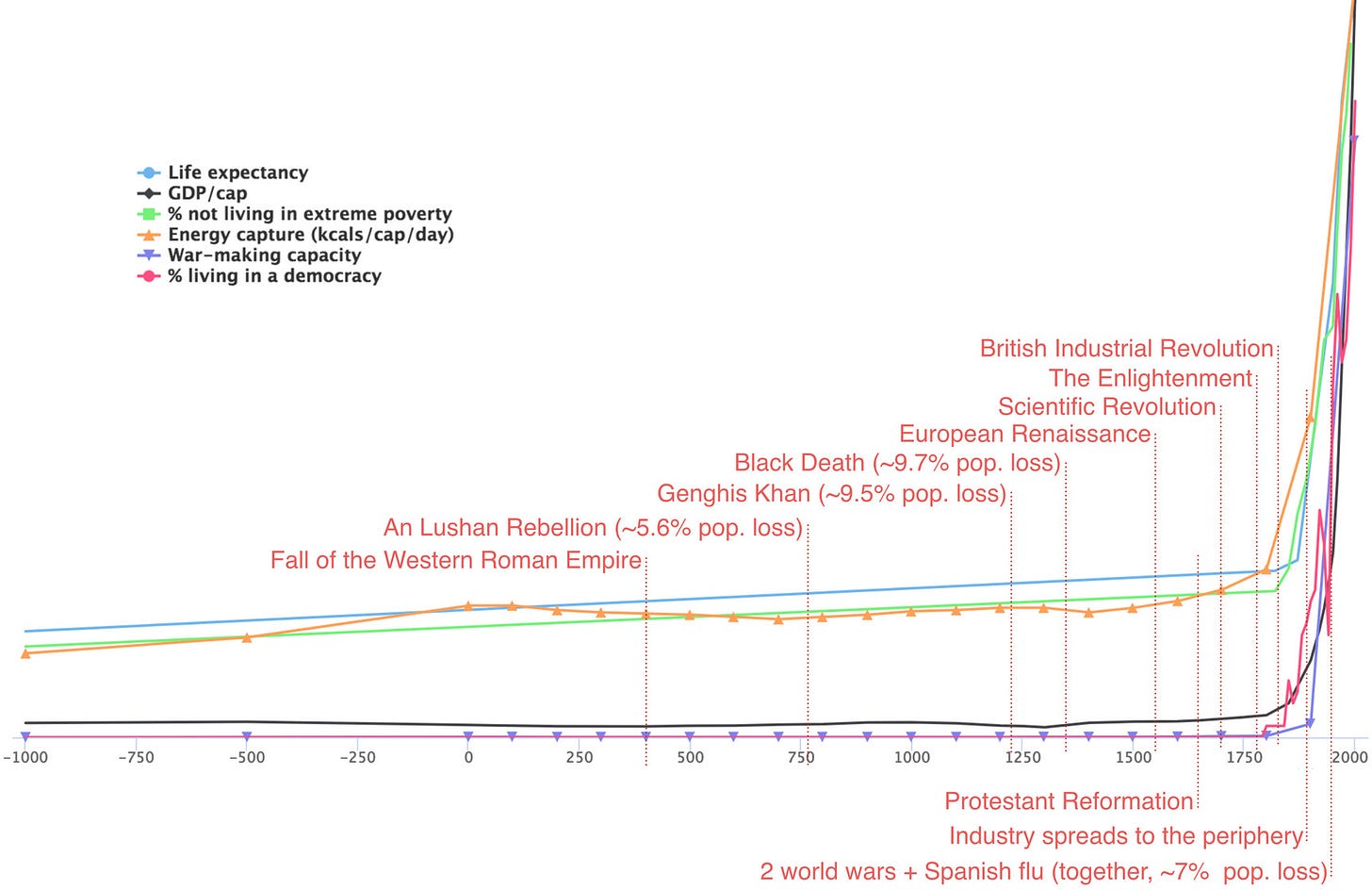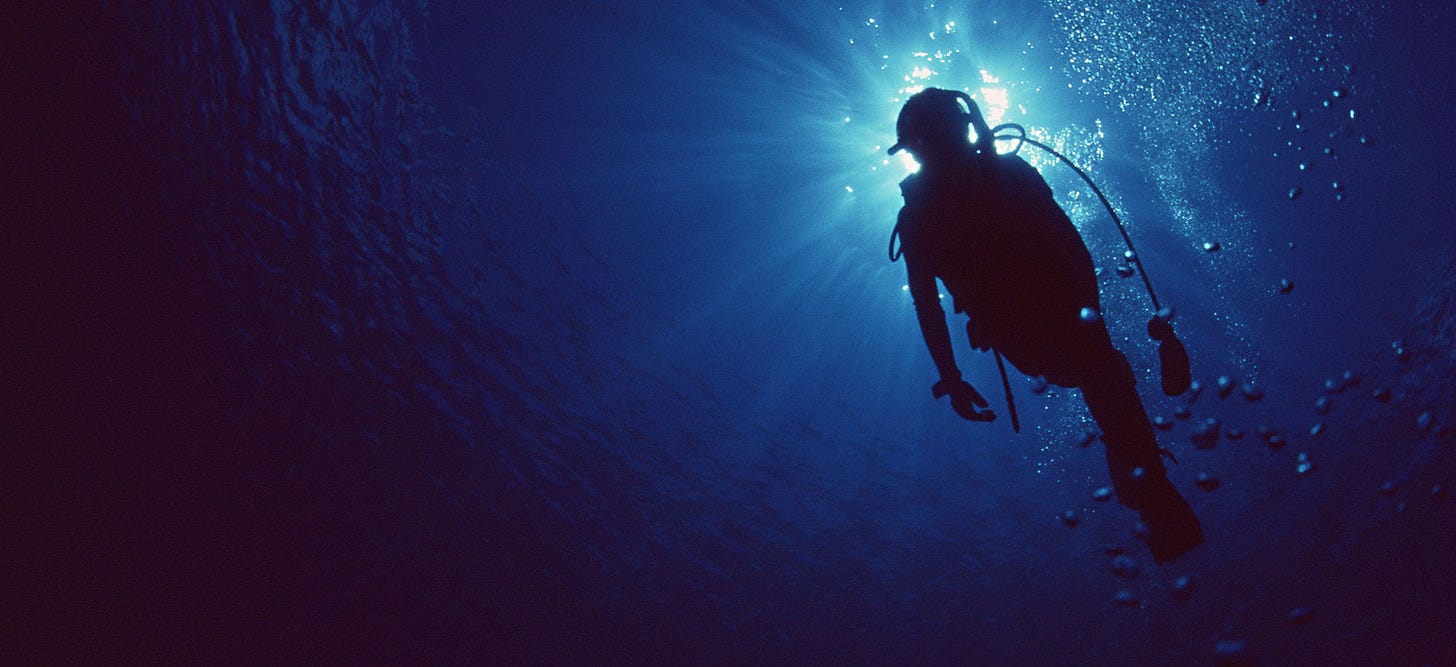The Illusion of Reality: The Water is Way Deeper Then We Thought
We Have No idea Whats Going On
In the grand theatre of theoretical physics, there are moments when the script must be rewritten, when the stage itself undergoes such a transformation that the players can scarcely recognize it. Recent scientific advancements in the past two decades indicate we’re entering such a moment.
What I’m about to describe is not merely a shift in perspective, but a tectonic upheavel, as profound as Galileo’s telescope which redefined the heavens.
Bear in mind, it took centuries of relentless effort for heliocentrism to gain widespread acceptance and these recent discoveries are likely to follow a similar path. Galileo died in 1642, and it wasn't until 1822 that the Catholic Church finally lifted its ban on heliocentric books.
Empiricism & the Scientific Method
Tim Urban asks us to consider human history as a 1000 page book, with each page representing 250 years of human history.
The really ancient Sumerians, who first came down from the mountains of modern day Turkey and Iran, don’t start until page 970. Buddhism begins on page 989 while Christianity begins on page 993.
What’s evident is that nothing happens until the final 1-2 pages, suggesting we currently live in the most extreme historical anomaly of human progress in all of history.
What happened on those last two pages to kick off civilizational progress?
The scientific revolution. It drove the enlightenment, the industrial revolution and the rise of empiricism as a pillar of Western thought. The Greeks were smart but handicapped without the scientific method.
The following chart from this Vox article emphasizes how human progress goes completely parabolic when the scientific revolution kicks off.
Science is the only tool discovered to date which reliably produces and compounds technological advancements. Nothing has relieved more suffering in the world then science. It is the flashlight used to peer into the surrounding darkness.
Empiricism gave us Darwinian evolution, cellular and genetic theory as well as anti-septics. Physics went from a sort of mysticism to the towering achievements of quantum theory and general relativity, which describe the universe at vastly different scales and under different conditions. One describes the probabilistic dance of subatomic particles and the other, the vast, curving expanse of cosmological space-time.
The grand challenge in the sprawling landscape of theoretical physics lies in uniting these two foundational but fundamentally incompatible theories.
Spacetime is Not Fundamental
Since the scientific revolution, physicists trusted the physical world could be understood because it could be measured. But when Heisenberg demonstrated in 1927 that subatomic particles changed behavior when observe all of physics was upended.
Schrödinger deepened the issue by proving electrons were just a series of probabilities which collapsed into one state when observed. If a continuous wave function always becomes discrete when observed by humans, how can reality even be knowable? Said another way, if the cat is both alive and dead until observed, why not the whole universe?
Particle physicists, probing the minutiae of the universe with instruments like the Large Hadron Collider in Geneva, have long relied on Feynman diagrams to tame the challenging equations that govern subatomic interactions.
These diagrams, born of Richard Feynman’s genius, translate complex integrals into manageable visual snapshots, depicting particles meeting and parting at precise points in space and time. Yet, even with their elegant simplicity, the calculations demand summations over countless intricate diagrams, considered a laborious and limiting task of modern particle physics.
An Example of Feynman Diagrams
In 2013, a paradigm shift emerged from the mind of theoretical physicist Nima Arkani-Hamed and his team. They introduced the amplituhedron, a multi-dimensional geometric wonder that promises to revolutionize our understanding of particle interactions. The amplituhedron distills the chaos of quantum calculations into the serene simplicity of geometry, reducing the summation problem to a single term: finding the volume of this abstract shape.
What makes the amplituhedron truly astonishing is its ability to describe particle interactions without invoking the familiar coordinates of space and time. This revelation hints at a staggering possibility: space-time, the very stage on which our perceivable the universe unfolds, might not be fundamental at all. Instead, it seems to emerge from a deeper, mysterious geometric structure.
The Amplitudehedron
The flashlight of science has seen something unnerving and implications are seismic.
Everything we know about the natural world, every physical law, every constant, all objects we see, can be seen as emergent properties, not fundamental truths. This shifts the foundations, unsettling our most basic assumptions about the universe.
In this new vista, the elegant dance of particles and the grand curvature of space-time would be seen as mere projections of a deeper, hidden reality yet undiscovered. The modern scientific pillars of quantum theory and general relativity are emergent from a deeper structure.
To summarize, if spacetime is not a fundamental property of the universe then we have no fucking clue what is actually going on.
In Evolutionary Game Theory Fitness Trumps Truth
That spacetime is not fundamental finds an intriguing partner in the work of computational neuroscientist Dr. Donald Hoffman.
The radical insights into the nature of reality and perception from his team at UC Irvine challenges our deepest assumptions about the accuracy of what we see and experience everyday.
In his TED Talk and book, "The Case Against Reality," Dr. Hoffman builds on the work of evolutionary game theory pioneered by John Maynard Smith in the 1970s, coming to the conclusion that the odds humans are able to perceive anything about reality through our senses is zero.
Evolutionary game theory is a mathematical representation of Darwinian evolution. It employs "fitness payoff functions" (clunkily named) to quantify the success of survival and reproduction strategies. These payoffs, expressed numerically, reflect the benefits accrued by competing agents within the game. A higher payoff translates to greater reproductive success, ensuring that winning traits dominate future generations
Consider a simple game with two strategies: Hawk (aggressive) and Dove (peaceful). When two individuals meet, their payoffs depend on their chosen strategies:
Hawk vs. Hawk: Both fight, incurring high costs and low payoffs.
Hawk vs. Dove: The Hawk wins easily, gaining a high payoff, while the Dove retreats with little to nothing.
Dove vs. Dove: Both share resources without conflict, each receiving a moderate payoff.
The payoff matrix for this interaction looks like this:
Hawk Dove
Hawk (-10,-10) (10, 0)
Dove (0, 10) (5, 5)
Hawk vs. Hawk: Both get -10 (cost of fighting).
Hawk vs. Dove: Hawk gets 10, Dove gets 0. (Hawk wins)
Dove vs. Hawk: Dove gets 0, Hawk gets 10. (Hawk wins)
Dove vs. Dove: Both get 5 (sharing the resource).
Over many iterations, the strategy yielding the higher payoff proliferates, shaping the traits of a population.
Around the same time Dr. Arkani-Hamed discovered the amplitudehedron, Hoffman’s lab uncovered a profound insight: that an accurate representation of reality is not required for survival and reproduction
In simulations using two sets of agents, one optimized for fitness and the other optimized to see the reality of the environment, the agents optimized for fitness always outcompeted those optimized to see reality accurately.
The unsettling implication? Our sensory systems and cognitive faculties, honed by evolution, have virtually no chance of perceiving an accurate representation reality. Said another way, in Darwinian evolution fitness always trumps truth.
This discovery raised the next pivotal question: do the fitness payoff functions that drive evolutionary success preserve any structure of the underlying reality?
Hoffman’s team explored this question using branch of mathematics called holomorphism, which studies the preservation of structural properties within data sets undergoing transformations.
Hoffman's team found that evolution preserves only fitness-relevant information and does not preserve any structure of the underlying reality or truth. Our vision, hearing, and other senses retain and utilize only fitness-critical data, with no representation the actual world.
Building on these findings, Hoffman's "Interface Theory of Perception" posits that our senses have evolved to perceive objects in our world similar to the icons of an iPhone App. The App is a useful interface but is not an accurate structural representation the toggling of electrical voltages in the hardware underlying the icon. Just as you don't need to understand the inner workings of a computer to send an email, our perceptions offer a user-friendly interface that bears no resemblance to the architecture of reality that underlies it.
Thus, while something real underlies our perceptions of a tree, a dog, or a house, these perceptual icons bear no resemblance to the underlying reality. Our evolved sensory systems are essentially a dumbed-down virtual reality headset, sparing us from the overwhelming complexity of the truth. Without filters or an interface we would drown in the information. Notably psychedelic compounds, like psilocybin mushrooms or LSD, dial down the headset filter so more perceptual information rises to consciousness.
In this view, humans navigate the world with a streamlined interface, evolved for fitness, not for truth. This is a profound departure from our assumptions about the nature of reality.
The Hard Problem of Consciousness
To quickly review, the theoretical physicists are indicating that spacetime is emergent rather then fundamental to the universe. Spacetime appears to emerges from geometric structures like the amplitudehedron and to unite general relativity and quantum mechanics spacetime must be discarded.
New insights from evolutionary game theory dovetail with the idea that spacetime is emergent, indicating our perceptual systems evolved to construct a simple world of icons optimized for fitness rather perceiving the truth of reality. Spacetime may turn out to similarly exists only within our perceptual VR headsets.
At the heart of these intertwined revelations lies the hard problem of consciousness: the question of how and why subjective experiences arise from physical processes. Traditional materialist views hold that consciousness emerges from neural activity in the brain and if we keep digging for more neural correlates of function, at some point consciousness spontaneously emerges.
But what if the brain is just a perceptual icon? What if the brain, which neuroscientists have presumed to be a correlate of consciousness, does not even exist inside our skulls until observed?
The bold stance taking hold within the field of consciousness research is that rather then consciousness emerging from the physical world of spacetime, our physical world of spacetime emerges from consciousness itself.
This aligns with the quantum phenomenon that electrons (and thus reality itself) seem to exist as a probability space until observed by a conscious agent. It is only when observed does anything we perceive become discrete.
Said another way, the spirit of being generates the universe into a structure of meaning, because without a conscious observer, the universe is a field of indeterminate possibility. This indicates that everything you see in the world makes itself manifest in accordance with your aims, i.e. you see only what you will into being.
Grappling with these very same topics, Einstein once said that “matter is spirit reduced to the point of visibility. There is no matter.”
The Water is Deeper Then We Thought
Kurt Gödel’s Incompleteness Theorem, unveiled by the Austrian logician in 1931, stands as one of the towering intellectual achievements of modern times. It illuminated the inherent limitations of our frameworks for understanding the world, demonstrating that some truths lie forever beyond the reach of formal systems.
As we venture into the next phase of scientific inquiry, where the boundaries between science, philosophy, and spirituality blur, Gödel’s insights remind us of the profound complexity we face. If science is a system striving to map the vastness of reality, it can never achieve a final theory of everything; it will only unearth new layers of truth.
Perhaps it is in fact turtles all the way down.
Since the aim of good science is to break its own models, it’s said that science progresses one funeral at a time,. It’s the the death of a model that points us to the next discovery. In this case, it’s the death of spacetime and the implications are unsettling.
There is something out there, outside of spacetime, from which our world emerges and our perceptual systems are not tuned to see any hint of its true form.
The always prescient Nietzsche famously said “battle not with monsters, lest ye become a monster, and if you gaze into the abyss, the abyss gazes also into you.”
And so we humans journey onward into the abyss, guided only by a flickering flashlight and the indomitable human spirit.





